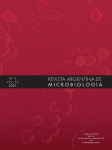Ver ítem
- xmlui.general.dspace_homeCentros e Institutos de InvestigaciónCICVyA. Centro de Investigación en Ciencias Veterinarias y AgronómicasInstituto de BiotecnologíaArtículos científicosxmlui.ArtifactBrowser.ItemViewer.trail
- Inicio
- Centros e Institutos de Investigación
- CICVyA. Centro de Investigación en Ciencias Veterinarias y Agronómicas
- Instituto de Biotecnología
- Artículos científicos
- Ver ítem
Brucella canis Group 2 isolated in Argentina = Brucella canis Grupo 2 aislado en Argentina
Resumen
The aim of this study was to estimate the diversity and prevalence of both groups of Brucella canis 1 and 2 with and without deletion respectively in different areas of Argentina. A total of 104 bacterial cultures were typed as B. canis strains using the classical biotyping method. Two PCR assays were performed to confirm that all isolates were B. canis and not Brucella suis. The differentiation between groups 1 and 2 was achieved using another PCR assay
[ver mas...]
The aim of this study was to estimate the diversity and prevalence of both groups of Brucella canis 1 and 2 with and without deletion respectively in different areas of Argentina. A total of 104 bacterial cultures were typed as B. canis strains using the classical biotyping method. Two PCR assays were performed to confirm that all isolates were B. canis and not Brucella suis. The differentiation between groups 1 and 2 was achieved using another PCR assay and the diversity of B. canis isolates was assessed with four MLVA_16 markers. All strains belonged to Group 2. Bruce 09 marker (MLVA_16 assay) showed the greatest diversity. Only Group 2 of B. canis was identified among the strains evaluated. The markers chosen from the MLVA_16 allowed us to detect genetic diversity among the strains of B. canis studied.
[Cerrar]
El objetivo de este trabajo fue estimar la diversidad y la prevalencia de ambos grupos de Brucella canis 1 y 2 (con y sin deleción, respectivamente) en diferentes áreas de Argentina. Un total de 104 cultivos bacterianos se tipificaron como cepas de B. canis usando biotipado clásico. Se realizaron dos ensayos de PCR para confirmar que todos los aislamientos eran B. canis y no Brucella suis. La diferenciación entre los grupos 1 y 2 se logró con otro ensayo
[ver mas...]
El objetivo de este trabajo fue estimar la diversidad y la prevalencia de ambos grupos de Brucella canis 1 y 2 (con y sin deleción, respectivamente) en diferentes áreas de Argentina. Un total de 104 cultivos bacterianos se tipificaron como cepas de B. canis usando biotipado clásico. Se realizaron dos ensayos de PCR para confirmar que todos los aislamientos eran B. canis y no Brucella suis. La diferenciación entre los grupos 1 y 2 se logró con otro ensayo de PCR, y la diversidad entre las cepas de B. canis se obtuvo mediante el empleo de cuatro marcadores del ensayo de MLVA_16. Todas las cepas pertenecieron al grupo 2. El marcador Bruce 09 (ensayo MVLA-16) mostró la mayor diversidad. Sólo se halló el Grupo 2 de B. canis entre las cepas estudiadas. Los marcadores del MLVA_16 permitieron detectar la presencia de diversidad genética entre las cepas de B. canis analizadas.
[Cerrar]

Autor
Boeri, Eduardo Jorge;
Madariaga, María Julia;
Dominguez, María Luz;
Teijeiro, María Luisa;
Fernandez, Natalia Mercedes;
Elena, Sebastián Alejandro;
Trangoni, Marcos David;
Fuente
Revista Argentina de Microbiología 53 (2) : 98-103 (April–June 2021)
Fecha
2021-06
Editorial
Elsevier
ISSN
0325-7541
1851-7617
1851-7617
Formato
pdf
Tipo de documento
artículo
Palabras Claves
Derechos de acceso
Abierto
 Excepto donde se diga explicitamente, este item se publica bajo la siguiente descripción: Creative Commons Attribution-NonCommercial-ShareAlike 2.5 Unported (CC BY-NC-SA 2.5)
Excepto donde se diga explicitamente, este item se publica bajo la siguiente descripción: Creative Commons Attribution-NonCommercial-ShareAlike 2.5 Unported (CC BY-NC-SA 2.5)

